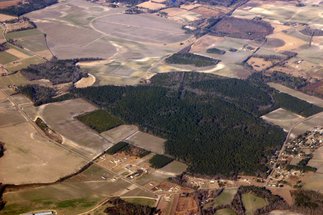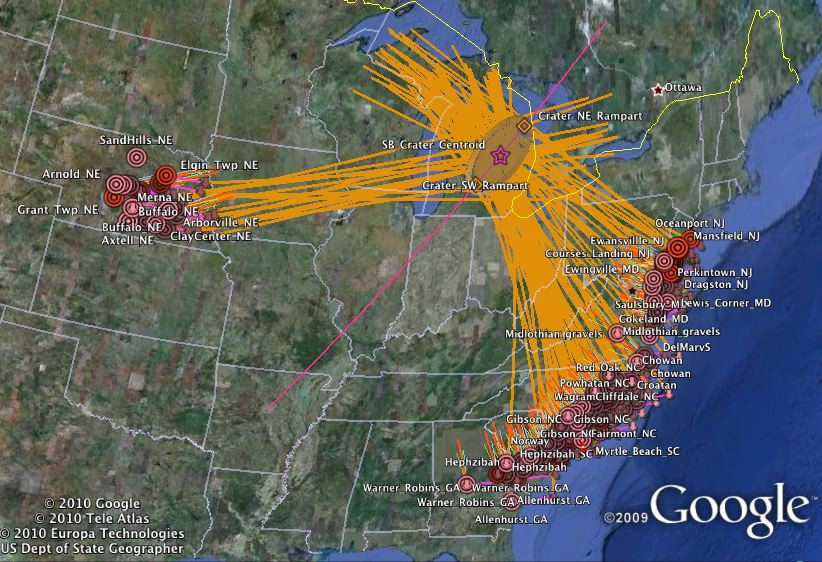 Carolina bays in North Carolina (Wikipedia).
Carolina bays in North Carolina (Wikipedia). Today there are two main schools of thought about how the Carolina bays formed: (1) through wind-wave action associated with Pleistocene conditions unlike those of today; and (2) as impact sites of debris ejected by a comet strike in Michigan or Canada.
My impression is that the geomorphological (i.e., terrestrial) explanation enjoys a lot of support from geologists who specialize in the Pleistocene. I'm just going to paste in a paragraph from the Wikipedia entry that sums it up:
This page proposes that
 Orientations of Carolina bays and similar features in Nebraska used to suggest impact site at Saginaw Bay (page reference in text).
Orientations of Carolina bays and similar features in Nebraska used to suggest impact site at Saginaw Bay (page reference in text). You'll notice I have bolded the word "Illinoisan" in the quote above. That brings us to the next question.
Multiple lines of evidence suggest that, even if the Carolina bays were the result of an extraterrestrial event rather than terrestrial processes, they formed long before humans were present in eastern North America. The Illinoian stage of the Pleistocene referenced above dates to about 190-130 thousand years ago.
This paper by Mark Brooks et al. (2001) discusses stratified sequences of natural deposits in a Carolina bay that have been directly dated by radiocarbon to tens of thousands of years before the Younger Dryas (12,900 years ago) impact proposed by Firestone et al. (2007). That paper also details encroachment of a sand dune over and into a Carolina bay at around 48,000 years ago, indicating that the bay has to be older than 48,000 years.
Because many Carolina bays held water, they were attractive to both animals and humans in the regions they occurred. This 2010 paper (also with Mark Brooks as senior author) describes the presence of archaeological sites associated with Carolina bays near the Savannah River. Clovis artifacts are associated with the bays, which means that the bays could not have been the result of some event that "wiped out" the Clovis peoples: the bays were there before, during, and after the Early Paleoindian period.
Conclusion
I used "terrestrial or extraterrestrial" in the title of this post because I thought it would attract readers. While I'm curious about that question, however, it doesn't ultimately appear to have much bearing on the early prehistory of the Eastern Woodlands. The Carolina bays, however they were formed, predate the Paleoindian period by at least tens of thousands of years - there's a lot of positive evidence for that. Even if a comet strike at about 12,900 years ago did precipitate the Younger Dryas and cause environmental changes to which human societies would have had to adjust, that impact did not produce the Carolina bays.
No-one would have been around to experience the effects of a very ancient (e.g., Illinoian age) impact into the ice sheet. Maybe I should have titled this post "If a comet hits the ice but there's no-one around to see it, does it make a difference?" It does, of course, if it re-shaped the environment in some way that was significant to later peoples. But I don't think it is those kinds of effects that most extraterrestrial impact fans are excited about.


 RSS Feed
RSS Feed
